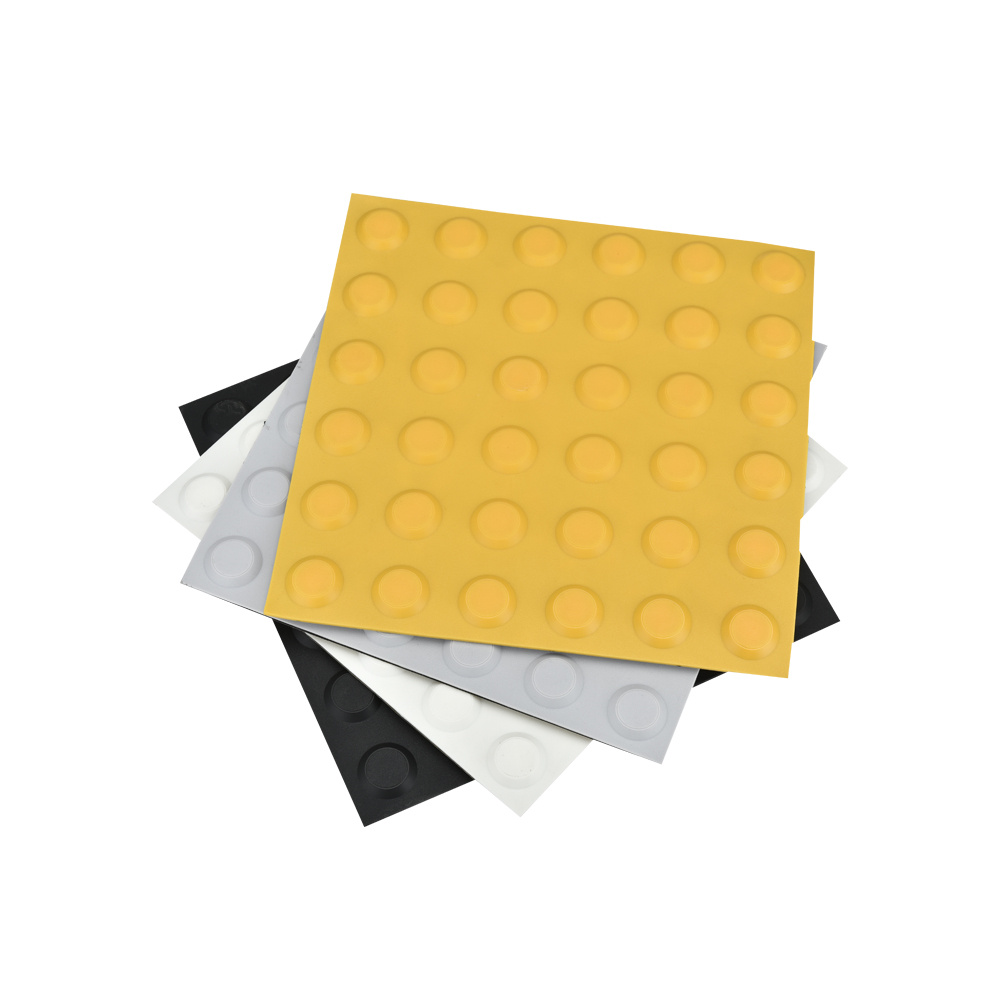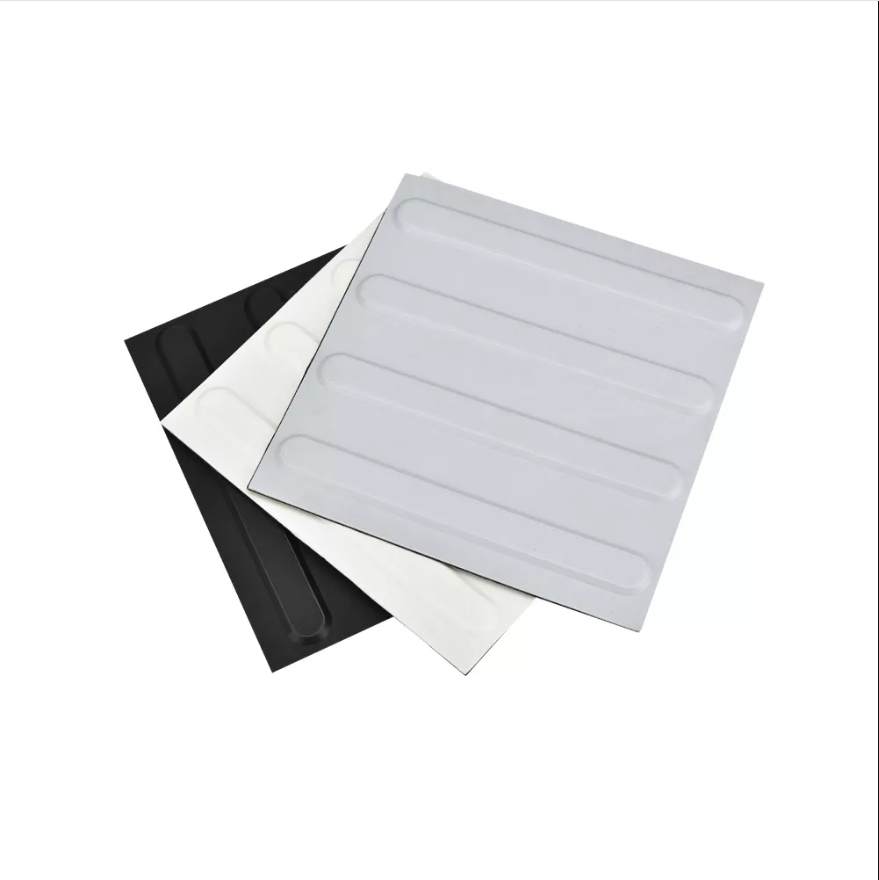TongXi Industrial Zone, YongKang City, ZheJiang Prov., China.
Views: 0 Author: Site Editor Publish Time: 2025-07-15 Origin: Site
Tactile tiles are essential for helping visually impaired individuals navigate public spaces safely. But did you know that not all tactile tiles are the same? Understanding the different types can greatly enhance urban accessibility.
In this post, we’ll discuss the various types of tactile tiles, their benefits, and what to consider when choosing the right one for your needs.

Tactile tiles are raised or textured surfaces that help individuals, particularly those with visual impairments, navigate public spaces. These tiles provide clear tactile cues that allow people to feel their way around obstacles, ensuring safer and more efficient movement in busy environments.
Purpose: Tactile tiles are designed to guide visually impaired individuals, alerting them to changes in direction, hazardous areas, or specific pathways, such as pedestrian crossings and train platforms.
Materials Used: Typically, tactile tiles are made from durable materials like carbon steel, polyurethane, and stainless steel. These materials ensure that the tiles last for years, even in high-traffic or outdoor environments.
Tactile tiles play a key role in improving urban accessibility. They are a critical part of designing spaces that are safe and inclusive for everyone.
Pedestrian Safety: These tiles help prevent accidents by providing clear visual and tactile indicators, making public spaces safer for everyone, especially those with limited vision.
Legal Compliance: Tactile tiles are required by law in many countries to meet accessibility standards. For instance, the Americans with Disabilities Act (ADA) mandates their use in certain public areas, ensuring that people with disabilities can navigate spaces independently.
Improved Mobility: With tactile tiles, visually impaired individuals can move around more confidently and safely. These tiles reduce the chances of accidents and allow for smoother transitions between different areas.
Tactile tiles are not just functional—they help create a more inclusive environment for all pedestrians, ensuring safe navigation through public spaces.
Tactile tiles come in various designs, each serving a unique purpose to guide visually impaired individuals safely through public spaces. Here are the most common types of tactile tiles:
What Are Blister Tactile Tiles?
Blister tactile tiles are the most widely used type, known for their raised bumps that provide a distinct tactile feel.
Design and Texture
These tiles feature dome-shaped bumps that make them easy to identify underfoot. The texture ensures clear tactile feedback, aiding smooth navigation.
Applications
Primarily used in crosswalks and pedestrian crossings, these tiles alert individuals to the presence of a street or dangerous areas.
Benefits for Visually Impaired Individuals
Blister tiles offer high precision, ensuring that individuals can detect changes in the environment and make informed decisions while walking.
What Are Corduroy Tactile Tiles?
Corduroy tactile tiles have a series of parallel raised bars designed to alert individuals to hazards or changes in direction.
Design Features
The bars are evenly spaced to create a unique tactile pattern that signals caution.
Common Use Cases
These tiles are commonly used near train station platforms and other areas where warning of a sudden change in direction is necessary.
Thicker Chain Plates
Thicker plates help improve the strength and durability of the tiles, making them suitable for high-traffic locations.
What Are Lozenge Tactile Tiles?
Lozenge-shaped tactile tiles provide a different tactile experience, featuring a series of raised, diamond-shaped patterns.
Design and Tactile Feedback
Their design helps guide users through busy areas, offering a clear signal for navigation.
Uses
Often installed on platform edges or bus stops, these tiles help individuals navigate through public transportation areas.
Enhanced Wear Resistance
Lozenge tiles are often treated with deep quenching, making them resistant to wear and ideal for high-traffic locations.
What Are Directional Tactile Tiles?
Directional tactile tiles are designed to guide pedestrians along a specific path, usually by using arrows or lines.
Design Features
The arrows or lines indicate a clear path, allowing for efficient movement in busy public spaces like sidewalks or building entrances.
Common Installations
These tiles are typically installed in areas where people need to follow a specific direction, such as at crosswalks or inside buildings.
Customizable Length Options
These tiles can be tailored to fit different layouts, making them ideal for various environments.
What Are Cycleway Tactile Tiles?
Cycleway tactile tiles are specifically designed to separate bike paths from pedestrian walkways.
Design and Texture
These tiles are often textured to make them distinguishable from pedestrian pathways, alerting users to the presence of a bike lane.
Purpose
Their primary goal is to reduce accidents by clearly distinguishing between pedestrian and cyclist areas.
Use Cases
Commonly found at bike lanes or intersections, they help improve safety in areas where pedestrians and cyclists share space.
Tactile tiles come in a variety of materials, each offering unique benefits suited to different environments. Let’s take a look at the most common materials used:
What Are Polyurethane Tactile Tiles?
Polyurethane tactile tiles are made from a flexible and durable plastic material that provides excellent tactile feedback.
Characteristics and Benefits
These tiles are highly resistant to wear, making them ideal for areas with heavy foot traffic. They are also weather-resistant, maintaining their integrity even in extreme conditions.
Durability and Weather Resistance
Polyurethane is resistant to both heat and cold, which makes these tiles perfect for outdoor environments where other materials may degrade.
Why They Are Ideal for Outdoor Use
Due to their resilience to UV rays and moisture, polyurethane tiles are commonly used in streets, parks, and public spaces exposed to weather conditions.
Cost and Longevity
These tiles offer a good balance of affordability and durability. While their initial cost may be higher than some other materials, they offer long-term value due to their extended lifespan.
Strong Tensile Strength
Polyurethane tiles can withstand high tensile forces, ensuring they don’t crack or break easily, even under stress.
What Are Stainless Steel Tactile Tiles?
Stainless steel tactile tiles are made from metal, offering unmatched strength and a sleek, modern appearance.
Properties and Advantages
Known for their corrosion resistance, these tiles excel in environments exposed to moisture, chemicals, or harsh weather conditions.
Corrosion Resistance
Stainless steel’s natural resistance to rust makes it a popular choice in areas prone to dampness or salt exposure, like coastal regions or food processing plants.
Durability in Harsh Environments
These tiles are incredibly durable and can handle heavy loads, making them suitable for industrial settings where other materials might wear out quickly.
Common Applications in Industrial Settings
Stainless steel tiles are often found in factories, warehouses, and areas requiring heavy-duty, corrosion-resistant flooring.
What Are Ceramic and Concrete Tactile Tiles?
Ceramic and concrete tactile tiles are more rigid materials that offer durability and long-lasting performance.
Differences Between Ceramic and Concrete Tactile Tiles
Ceramic tiles are typically more decorative and are easier to clean, while concrete tiles are stronger and more suited to industrial applications.
Durability and Slip Resistance
Both materials are highly durable, offering resistance to wear and slip, making them ideal for high-traffic areas like train stations and malls.
Applications in Urban and Commercial Environments
Ceramic and concrete tiles are frequently used in urban designs, including sidewalks, plazas, and commercial buildings due to their robustness and aesthetic versatility.
Sustainability
Concrete and ceramic tiles are made from natural materials, offering an eco-friendly alternative. Concrete, in particular, can be recycled, reducing its environmental impact.
These materials are chosen based on the specific requirements of each environment, offering both functional and aesthetic benefits in the design of tactile surfaces.
Selecting the right tactile tile for your project involves considering several factors. Let’s break down the essential things to keep in mind:
Choosing the right tactile tile requires understanding your specific needs. Here are key factors to consider:
Location
Think about where the tiles will be installed. Outdoor environments may require weather-resistant materials, while indoor spaces can prioritize aesthetics and comfort.
Climate
Extreme temperatures or moisture levels can affect the durability of certain materials. For areas exposed to harsh climates, opt for tiles made from corrosion-resistant materials like stainless steel or polyurethane.
Pedestrian Traffic
High-traffic areas need tiles that can withstand wear and tear, such as thicker, more durable materials like concrete or stainless steel. Lower-traffic spaces can use less heavy-duty materials.
Compliance with Accessibility Standards
Ensure your chosen tiles meet local accessibility guidelines, such as the ADA in the U.S., which outlines specific requirements for the size, placement, and texture of tactile tiles.
Budget Considerations
Your budget will play a role in material selection. While polyurethane and concrete tiles are often affordable, stainless steel and customized designs may come at a higher price but offer more longevity and resistance.
Proper installation is key to ensuring the effectiveness and longevity of tactile tiles. Follow these tips for the best results:
Placement Rules
Tiles should be placed at regular intervals to ensure clear guidance. The orientation of the tiles (e.g., directional arrows) must align with the intended path.
Distance and Alignment
The distance between tiles should follow industry standards to ensure consistency. Proper alignment ensures a seamless flow and prevents any obstacles that could confuse users.
Best Practices for High-Traffic Areas
In high-traffic areas, make sure to install tiles with thicker chain plates or materials that can handle more stress. This prevents premature wear and enhances the durability of the tiles.
Thicker Chain Plates
In high-stress environments, consider using tiles with thicker plates. These are more robust and resistant to damage caused by heavy foot traffic.
By keeping these factors in mind, you can ensure that the tactile tiles you select will be effective, durable, and compliant with relevant standards.

Tactile tiles are more than just a safety feature—they contribute to creating more inclusive, accessible urban spaces. Here’s how they help:
Tactile tiles play a vital role in improving accessibility for visually impaired individuals. Here's how they contribute:
Supporting Independent Navigation
Tactile tiles allow people with visual impairments to navigate spaces independently. The raised textures give them clear tactile cues, helping them understand their surroundings and make safe decisions.
Enhancing Public Safety and Reducing Accidents
By marking important areas like pedestrian crossings, platform edges, and hazardous zones, tactile tiles help reduce accidents. They provide vital warnings and guide people through potentially dangerous spaces, enhancing safety for everyone.
Investing in tactile tiles offers several financial advantages for both public spaces and businesses. Here are some of the key economic benefits:
Low Maintenance Costs
Tactile tiles are designed to last and require minimal upkeep. Their durability means you won’t need frequent repairs or replacements, saving on long-term maintenance costs.
Reduced Liability in Public Spaces
By installing tactile tiles, you can reduce the risk of accidents and injuries. This helps minimize potential legal liabilities, ensuring your space is safer for everyone.
Compliance with Legal Requirements (e.g., ADA Regulations)
Many countries have laws requiring tactile tiles to meet accessibility standards, such as the ADA in the U.S. Installing them ensures you comply with these regulations, avoiding potential fines or legal issues.
Cost-Effective for Long-Term Use
Despite their initial cost, tactile tiles are a wise investment in the long term. Due to their durability and low maintenance, they provide significant savings over time, especially in high-traffic areas.
Tactile tiles not only improve accessibility but also offer economic benefits that make them a smart choice for urban design.
Tactile tiles, including blister, corduroy, lozenge, directional, and cycleway tiles, each serve specific purposes to improve accessibility. These tiles help visually impaired individuals navigate safely in public spaces. Their durability, made possible by materials like polyurethane, stainless steel, and carbon steel, ensures they can withstand various environmental conditions. Tactile tiles are essential for creating safe, inclusive, and accessible urban environments.